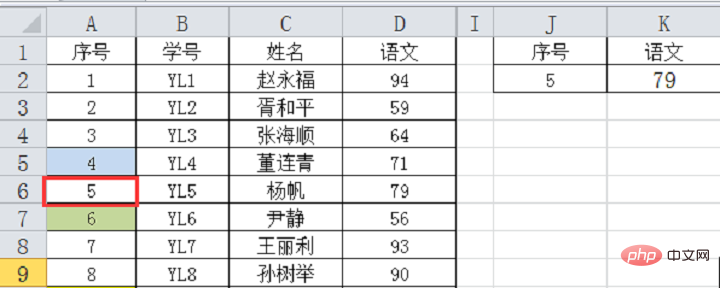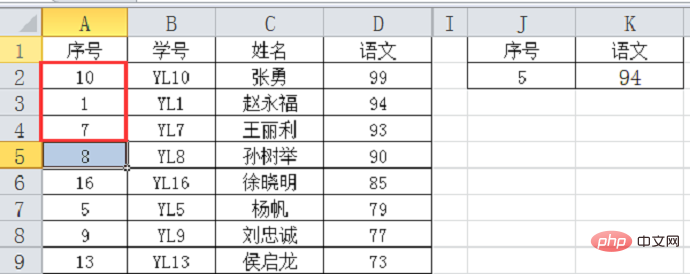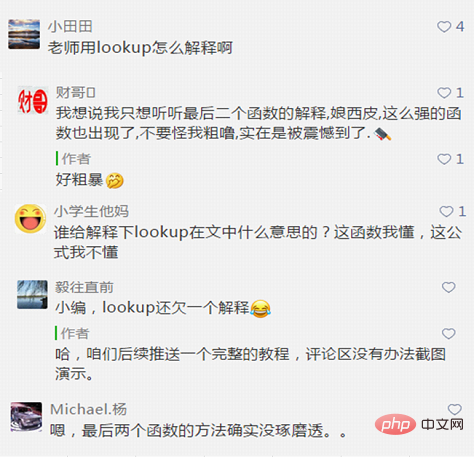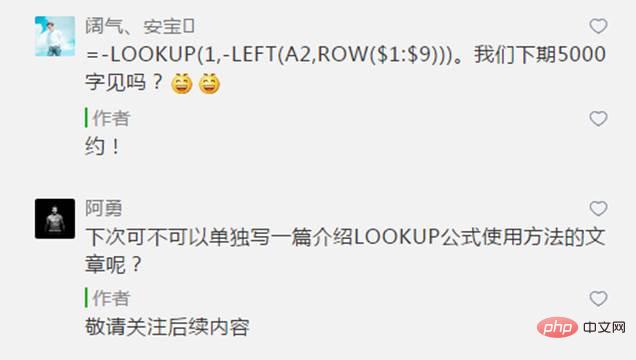Excel function learning: dichotomy principle of LOOKUP function
In the previous article "Excel function learning: 5 ways to use the LOOKUP function", we learned about the 5 ways to use the LOOKUP function. It is estimated that many friends don't understand it. Today I will give you details Let’s explain the dichotomy principle of LOOKUP. After understanding the principle, go back and read yesterday’s tutorial. I believe you will have a different understanding of LOOKUP.

In the previous article, we learned various routines of the LOOKUP function, and also mentioned many times that the search of the LOOKUP function is based on the dichotomy method, so in the end What is dichotomy? Let’s talk about this issue today.
Let’s still use yesterday’s example: search for results by serial number. The serial numbers are arranged in ascending order. The result of the formula =LOOKUP(J2,A2:D19) is correct.

1. Binary search principle
Binary search is to search the data in the search range according to Divide the number into two to find a piece of data in the middle, the middle value, and then compare it with our search value and the middle value. When the middle value is equal to the search value, the result is obtained directly; when the middle value is less than the search value, the binary search comparison is continued downward (that is, the binary search is continued in the lower half of the data excluding the middle value). method search); when the intermediate value is greater than the search value, the binary search comparison continues upward (that is, the binary search continues in the upper half of the data excluding the intermediate value). If no data equal to the search value is found after dichotomizing until the last data: if the last data is less than the search value, then use the position of the last data to obtain the result value; if the last data is greater than the search value, then search upwards The data whose position is closest to the last data is less than or equal to the search value, and then the result is obtained based on the position of this data.
I guess many friends will be confused by this explanation. Let’s take a look at the above example to see how to find the Chinese score of 79 through serial number 5.
First comparison: There are 18 data in the search range A2~A19, and the middle position is 18÷2=9, that is, the middle value is 9 in cell A10. Obviously the search value 5 is less than 9, so continue to search upwards in A2~A9;
Tips: If the number of data in the search range is an odd number, the middle position is (number 1) ÷ 2, for example, if it is row 11, The middle position is (11 1) ÷ 2 = 6; if the number of data is an even number, the middle position is (number) ÷ 2.

Second comparison: There are only 8 data, the middle position is 8÷2=4, the middle value is 4 in cell A5, the search value 5 is greater than 4, so Continue looking down in A6~A9. Note that there are only four numbers below at this time, and the data below 9 are directly excluded during the first search.

The third comparison: 4 data, the middle value is 6 of A7, the search value 5 is less than 6, so search upward. At this time, there is only one data left, 5 in cell A6, which is consistent with the search value, so the data 79 in column D corresponding to 5 is obtained.

It is very difficult to understand the dichotomy through just such an example. Let’s look at another example. Arrange the data in the table above in descending order of scores, or search for Chinese scores by serial number 5. The formula does not need to be modified. Because the order of the serial number column is out of order and is not arranged in ascending order, an error occurs. The actual number is 79, and the formula yields 94. What's going on? Let’s look at it through dichotomy.
The first search: the middle value (9th data) is 18, the search value 5 is less than 18, so search upward in A2~A9;

Second search: The above 8 data, the middle value (the 4th data) is 8, the search value 5 is less than 8, continue to search upward in A2~A4;

The third search: the above 3 data, the middle value is 1, the search value 5 is greater than 1, search downward:

The fourth search: Now there is only one data 7 in cell A4. The search value 5 is less than 7. Therefore, using 7 as a reference, find the data with a position closest to 7 and a value less than 5 or equal to 5, that is, 1 in cell A3, and thus obtain the corresponding The Chinese value is 94.
Through these two examples, I think everyone should have a certain understanding of the dichotomy. Regarding this principle, there is only one sentence in the function description:

In practical applications, we don’t need to worry about what the dichotomy is, what is the middle position, whether to look down or up, this is all the work of the function, we only need to remember one thing : The data must be arranged in ascending order. If it cannot be arranged in ascending order, then design the formula according to the precise search routine of LOOKUP.
2. LOOKUP implements data rounding
That’s all the introduction to the principle of dichotomy. Next, we need to solve the two problems left before.
In the article on May 12, we used LOOKUP to solve a rounding problem. As a result, everyone left messages asking for an explanation:

So what caused this? What is this formula that everyone is talking about? Look at the picture below:

#It turns out that this formula uses the LOOKUP function to remove all numbers below the hundredth place, thereby achieving percentile rounding.
After understanding the principle of dichotomy, it is time for LOOKUP to explain it to everyone. First, explain the ROW (A:A)*100 part. It actually just gets a set of numbers. In order to make it clear to everyone, let’s make the range A:A smaller. We use =ROW(A1:A31)*100 as an explanation:


3. LOOKUP for data extraction
We also use LOOKUP for data extraction, so we have a 5000-word appointment:




For beginners, the usage of LOOKUP in the above two cases is too advanced. Even through these introductions, it is estimated that they have only a partial understanding. In fact, learning functions is a process. From understanding to understanding, from understanding to mastering , which requires a lot of practice and thinking. As long as everyone maintains a positive and optimistic attitude and can experience the fun of learning functions, success is not far away.
Related learning recommendations: excel tutorial
The above is the detailed content of Excel function learning: dichotomy principle of LOOKUP function. For more information, please follow other related articles on the PHP Chinese website!

Hot AI Tools

Undresser.AI Undress
AI-powered app for creating realistic nude photos

AI Clothes Remover
Online AI tool for removing clothes from photos.

Undress AI Tool
Undress images for free

Clothoff.io
AI clothes remover

Video Face Swap
Swap faces in any video effortlessly with our completely free AI face swap tool!

Hot Article

Hot Tools

Notepad++7.3.1
Easy-to-use and free code editor

SublimeText3 Chinese version
Chinese version, very easy to use

Zend Studio 13.0.1
Powerful PHP integrated development environment

Dreamweaver CS6
Visual web development tools

SublimeText3 Mac version
God-level code editing software (SublimeText3)

Hot Topics
 1657
1657
 14
14
 1415
1415
 52
52
 1309
1309
 25
25
 1257
1257
 29
29
 1230
1230
 24
24
 What should I do if the frame line disappears when printing in Excel?
Mar 21, 2024 am 09:50 AM
What should I do if the frame line disappears when printing in Excel?
Mar 21, 2024 am 09:50 AM
If when opening a file that needs to be printed, we will find that the table frame line has disappeared for some reason in the print preview. When encountering such a situation, we must deal with it in time. If this also appears in your print file If you have questions like this, then join the editor to learn the following course: What should I do if the frame line disappears when printing a table in Excel? 1. Open a file that needs to be printed, as shown in the figure below. 2. Select all required content areas, as shown in the figure below. 3. Right-click the mouse and select the "Format Cells" option, as shown in the figure below. 4. Click the “Border” option at the top of the window, as shown in the figure below. 5. Select the thin solid line pattern in the line style on the left, as shown in the figure below. 6. Select "Outer Border"
 How to filter more than 3 keywords at the same time in excel
Mar 21, 2024 pm 03:16 PM
How to filter more than 3 keywords at the same time in excel
Mar 21, 2024 pm 03:16 PM
Excel is often used to process data in daily office work, and it is often necessary to use the "filter" function. When we choose to perform "filtering" in Excel, we can only filter up to two conditions for the same column. So, do you know how to filter more than 3 keywords at the same time in Excel? Next, let me demonstrate it to you. The first method is to gradually add the conditions to the filter. If you want to filter out three qualifying details at the same time, you first need to filter out one of them step by step. At the beginning, you can first filter out employees with the surname "Wang" based on the conditions. Then click [OK], and then check [Add current selection to filter] in the filter results. The steps are as follows. Similarly, perform filtering separately again
 How to change excel table compatibility mode to normal mode
Mar 20, 2024 pm 08:01 PM
How to change excel table compatibility mode to normal mode
Mar 20, 2024 pm 08:01 PM
In our daily work and study, we copy Excel files from others, open them to add content or re-edit them, and then save them. Sometimes a compatibility check dialog box will appear, which is very troublesome. I don’t know Excel software. , can it be changed to normal mode? So below, the editor will bring you detailed steps to solve this problem, let us learn together. Finally, be sure to remember to save it. 1. Open a worksheet and display an additional compatibility mode in the name of the worksheet, as shown in the figure. 2. In this worksheet, after modifying the content and saving it, the dialog box of the compatibility checker always pops up. It is very troublesome to see this page, as shown in the figure. 3. Click the Office button, click Save As, and then
 How to set superscript in excel
Mar 20, 2024 pm 04:30 PM
How to set superscript in excel
Mar 20, 2024 pm 04:30 PM
When processing data, sometimes we encounter data that contains various symbols such as multiples, temperatures, etc. Do you know how to set superscripts in Excel? When we use Excel to process data, if we do not set superscripts, it will make it more troublesome to enter a lot of our data. Today, the editor will bring you the specific setting method of excel superscript. 1. First, let us open the Microsoft Office Excel document on the desktop and select the text that needs to be modified into superscript, as shown in the figure. 2. Then, right-click and select the "Format Cells" option in the menu that appears after clicking, as shown in the figure. 3. Next, in the “Format Cells” dialog box that pops up automatically
 How to use the iif function in excel
Mar 20, 2024 pm 06:10 PM
How to use the iif function in excel
Mar 20, 2024 pm 06:10 PM
Most users use Excel to process table data. In fact, Excel also has a VBA program. Apart from experts, not many users have used this function. The iif function is often used when writing in VBA. It is actually the same as if The functions of the functions are similar. Let me introduce to you the usage of the iif function. There are iif functions in SQL statements and VBA code in Excel. The iif function is similar to the IF function in the excel worksheet. It performs true and false value judgment and returns different results based on the logically calculated true and false values. IF function usage is (condition, yes, no). IF statement and IIF function in VBA. The former IF statement is a control statement that can execute different statements according to conditions. The latter
 How to type subscript in excel
Mar 20, 2024 am 11:31 AM
How to type subscript in excel
Mar 20, 2024 am 11:31 AM
eWe often use Excel to make some data tables and the like. Sometimes when entering parameter values, we need to superscript or subscript a certain number. For example, mathematical formulas are often used. So how do you type the subscript in Excel? ?Let’s take a look at the detailed steps: 1. Superscript method: 1. First, enter a3 (3 is superscript) in Excel. 2. Select the number "3", right-click and select "Format Cells". 3. Click "Superscript" and then "OK". 4. Look, the effect is like this. 2. Subscript method: 1. Similar to the superscript setting method, enter "ln310" (3 is the subscript) in the cell, select the number "3", right-click and select "Format Cells". 2. Check "Subscript" and click "OK"
 Where to set excel reading mode
Mar 21, 2024 am 08:40 AM
Where to set excel reading mode
Mar 21, 2024 am 08:40 AM
In the study of software, we are accustomed to using excel, not only because it is convenient, but also because it can meet a variety of formats needed in actual work, and excel is very flexible to use, and there is a mode that is convenient for reading. Today I brought For everyone: where to set the excel reading mode. 1. Turn on the computer, then open the Excel application and find the target data. 2. There are two ways to set the reading mode in Excel. The first one: In Excel, there are a large number of convenient processing methods distributed in the Excel layout. In the lower right corner of Excel, there is a shortcut to set the reading mode. Find the pattern of the cross mark and click it to enter the reading mode. There is a small three-dimensional mark on the right side of the cross mark.
 How to insert excel icons into PPT slides
Mar 26, 2024 pm 05:40 PM
How to insert excel icons into PPT slides
Mar 26, 2024 pm 05:40 PM
1. Open the PPT and turn the page to the page where you need to insert the excel icon. Click the Insert tab. 2. Click [Object]. 3. The following dialog box will pop up. 4. Click [Create from file] and click [Browse]. 5. Select the excel table to be inserted. 6. Click OK and the following page will pop up. 7. Check [Show as icon]. 8. Click OK.





